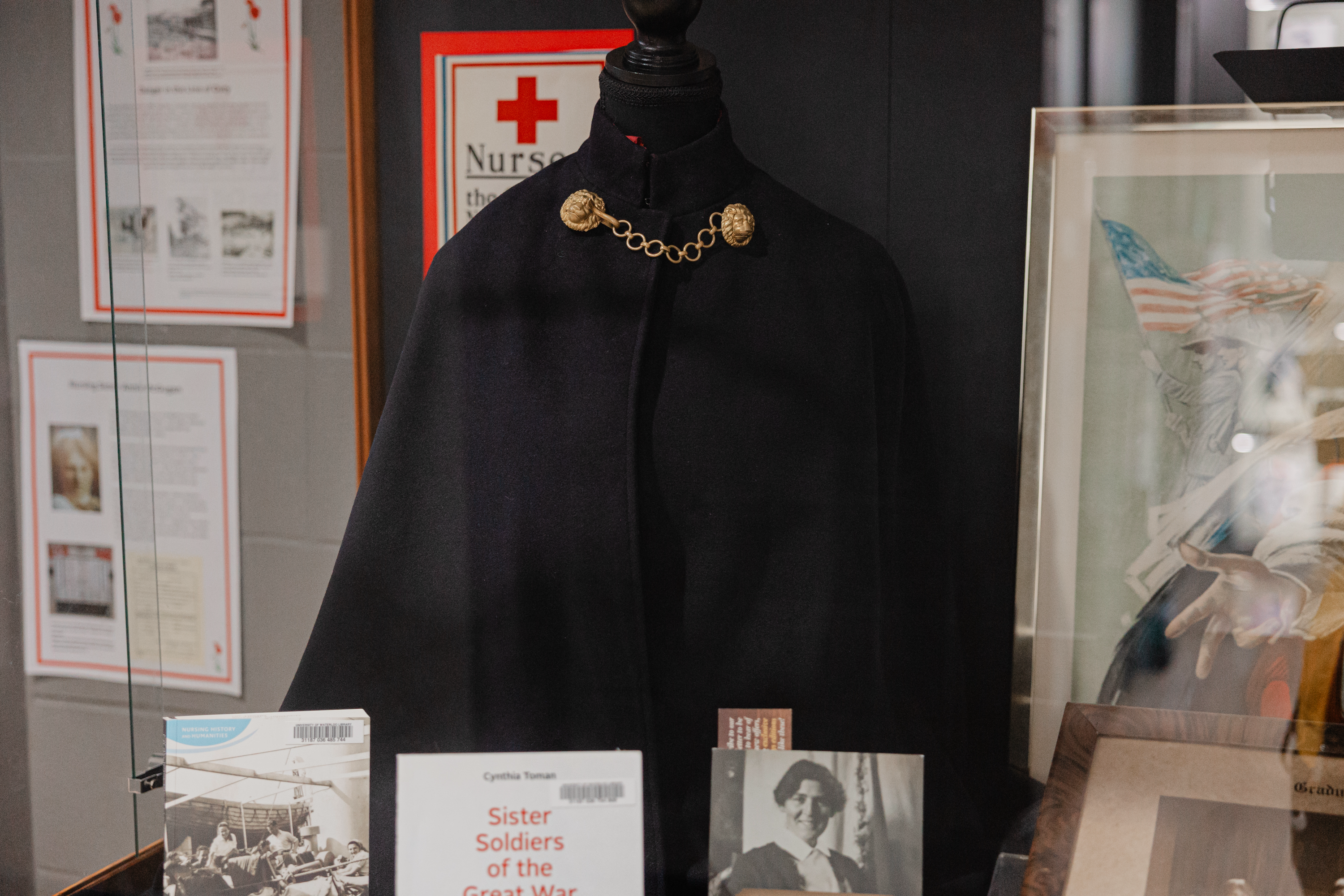
A display case showcasing a historical nurse's cape with gold details, several books, and framed photos commemorates the pivotal role of wartime nurses (Photo credit: Paul Sherk).
St. Jerome’s University is one of the four Affiliated and Federated Institutions of Waterloo (AFIW). Formerly named St. Jerome’s College, the institution was established in 1865, 92 years before UW. St. Jerome’s has a rich history, with Remembrance Day holding particular significance as many students and staff served in both the First and Second World Wars.
Inside St. Jerome’s Library hangs an Honour Roll listing the names of 337 students and faculty who served in the Second World War. An honour roll for the First World War was printed in May 1918 in Volume 20 of St. Jerome’s College’s student newspaper, the Schoolman. It lists 87 students, alumni, and faculty who served in the war. Print copies of the Schoolman are conserved in the library office and includes reporting of fallen or injured graduates. The newspaper captures a historic moment in time and provides insight to the student perspective in the midst of war.
The St. Jerome’s Library staff have been identifying students by manually checking student records with war records under the Library and Archives Canada (LAC), and at times British military records. With the limited information available, however, identifying all students has proved to be incredibly challenging.
The staff at St. Jerome’s Library, led by associate librarian Michelle Atkin, have put together a Remembrance Day display showcased in the archives case between the library entrance and the DRAGEN Lab. This year, it is focusing on the experiences of nurses during war. The display includes a First World War nursing cape and uniform on loan from the family of nursing sister Annie McGugan. Several pieces on wartime nursing are featured, including the book Grief in Wartime written by Dr. Carol Acton, professor in UW’s English department. An original Red Cross nursing recruitment poster and a reproduction of the Voluntary Aid Detachment recruitment poster are also displayed, the first on loan from Dr. Acton and the second with permission from the Canadian War Museum.
Dr. Acton’s PhD thesis was on First World War British poetry, and she has since read numerous accounts on various wars which have focused on life-writings. “The post-war period was marked by grief. Nearly every household knew somebody who had died,” she said. Dr. Acton decided to investigate how women expressed the experience of grief, first encountering work by Vera Brittain, British nurse and activist who wrote the memoir Testament of Youth.
Grief in Wartime explores expressions of combatants, nurses, and the seldom-mentioned women who had fiancés, husbands, brothers, and others who were killed in the war. It includes perspectives from various wars, such as World War I, World War II, the Vietnam War, and the Iraq War.
How did nurses respond to the death of patients, especially considering the overwhelming number they witnessed on a daily basis? Dr. Acton said: “There were no blood transfusions, so there wasn’t very much that they could do to help people survive. I wanted to see if that [expression of grief] was coming out somewhere. How [did] they look for some way of surviving this? A lot of it was between the lines — it’s quite subtle.”
The nursing environment was nuanced, described as a “middle position between civilian and the war zone” by Dr. Acton. Nurses worked with combatants all the while receiving messages about family members and loved ones serving in war. “At the same time, when you’re working in that environment you can’t afford to break down,” Dr. Acton said.
“The Canadian nurses, they were one of the groups that had nurses die in [enemy action] more than anyone else. That’s something to probably think about, I don’t think people maybe are aware of that,” Dr. Acton said. Canadian hospital ship Llandovery Castle was torpedoed by a German U-boat on June 27, 1918, killing all 14 nurses on board. 1918 also marked two Canadian Army Medical Corps (CAMC) hospital bombings in Europe, killing nurses in the line of duty. Many others died from disease, illness, and drowning.
The display at St. Jerome’s University is dedicated in remembrance to all those who have served and have been impacted by war. An honorary ceremony will happen on Nov. 11 at 11 a.m.





